
|
Now it is bright as 8.7 mag (June 18, Marco Goiato). It stays bright as 9 mag for a while. In the Southern Hemisphere, it stays observable in good condition for a long time until the comet will fade out. In the Northern Hemisphere, it will be unobservable soon.
Date(TT) R.A. (2000) Decl. Delta r Elong. m1 Best Time(A, h)
June 16 18 38.58 -35 34.6 1.313 2.300 161 9.2 1:05 ( 0, 20)
June 23 18 13.50 -40 56.2 1.290 2.279 162 9.1 0:13 ( 0, 14)
|
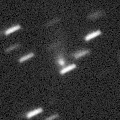
|
Now it is not observable. It will brighten up to 9 mag in summer, but it is hardly observable when it is bright. In the Northern Hemisphere, it is not observable until late December. In the Southern Hemisphere, it is observable from July to September, but it locates in extremely low.
Date(TT) R.A. (2000) Decl. Delta r Elong. m1 Best Time(A, h)
June 16 4 28.65 14 18.7 1.942 1.029 18 10.6 2:58 (241,-14)
June 23 4 50.55 10 31.0 1.822 0.959 22 10.1 3:00 (245,-15)
|
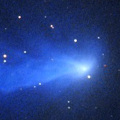
|
Now it is 11.5 mag (June 12, Juan Jose Gonzalez). It stays bright as 11 mag for a long time until autumn. In the Southern Hemisphere, it is not observable for a long time after this. In the Northern Hemispehre, it stays observable for a long time until the comet fades out. But it stays very low until autumn.
Date(TT) R.A. (2000) Decl. Delta r Elong. m1 Best Time(A, h)
June 16 7 1.14 50 29.9 3.441 2.633 31 11.2 21:02 (144, 13)
June 23 7 20.76 51 12.3 3.459 2.645 31 11.3 21:04 (145, 12)
|
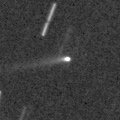
|
First return of a new periodic comet which brightened up to 13 mag in 2013. Brightening very rapidly. Now it is bright as 12.8 mag (June 14, Chris Wyatt). It will brighten up to 11 mag in summer. In the Southern Hemisphere, it stays observable in good condition all through this apparition. In the Northern Hemisphere, it is not observable at the high light from mid June to mid August.
Date(TT) R.A. (2000) Decl. Delta r Elong. m1 Best Time(A, h)
June 16 8 54.00 10 7.9 0.404 0.809 48 12.0 21:02 ( 96, 8)
June 23 8 43.52 3 50.0 0.346 0.798 42 11.3 21:04 ( 97, -4)
|
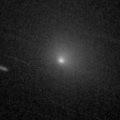
|
It brightened rapidly as expected. Now it is very bright as 10.8 mag (June 13, Chris Wyatt). It will fade out rapidly after this. In the Southern Hemisphere, it stays observable in excellent condition. It will be getting higher gradually after this also in the Northern Hemisphere.
Date(TT) R.A. (2000) Decl. Delta r Elong. m1 Best Time(A, h)
June 16 0 35.53 -26 13.2 0.915 1.343 87 11.5 2:58 (308, 6)
June 23 0 50.24 -24 16.5 0.919 1.371 90 12.3 3:00 (309, 10)
|
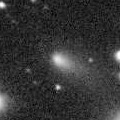
|
Now it is bright as 12.5 mag (June 13, Chris Wyatt). It will brighten rapidly, and brighten up to 7 mag from August to September. In the Northern Hemisphere, it will be observable in excellent condition. In the Southern Hemisphere, it will be unobservable from July to August. But it will be observable in good condition before and after that.
Date(TT) R.A. (2000) Decl. Delta r Elong. m1 Best Time(A, h)
June 16 20 55.46 41 31.9 0.993 1.544 100 12.2 2:58 (211, 82)
June 23 21 9.54 45 31.8 0.924 1.480 99 11.7 3:00 (186, 79)
|
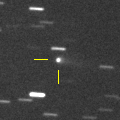
|
Now it is 14.4 mag (June 13, Chris Wyatt). It was expected to brighten up to 11 mag from summer to autumn. But actually, it is fainter than this ephemeris recently. It is observable in excellent condition in the Southern Hemisphere. It locates somewhat low in the Northern Hemisphere.
Date(TT) R.A. (2000) Decl. Delta r Elong. m1 Best Time(A, h)
June 16 22 13.32 -15 20.1 1.411 2.055 114 12.4 2:58 (331, 35)
June 23 22 21.18 -15 44.8 1.339 2.043 119 12.2 3:00 (336, 36)
|

|
Now it is 11.7 mag (June 12, Juan Jose Gonzalez). It stays 12 mag for a long time until spring in 2019. In the Northern Hemisphere, it stays observable in good condition for a long time, although it becomes unobservable temporarily from mid June to August. In the Southern Hemisphere, it is not observable until September.
Date(TT) R.A. (2000) Decl. Delta r Elong. m1 Best Time(A, h)
June 16 8 5.73 41 0.8 3.447 2.691 35 12.2 21:02 (129, 16)
June 23 8 10.21 38 48.2 3.507 2.682 30 12.2 21:04 (130, 11)
|
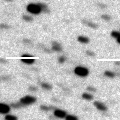
|
It is expected to approach to Sun down to 0.2 a.u. and brighten up to 3 mag in August. Now it is 15.2 mag (June 7, Ken-ichi Kadota). It is fainter than this ephemeris recently. In the Northern Hemisphere, it stays observable in the morning sky until early August when the comet brightens up to 6 mag. It is not observable at all in the Southern Hemisphere.
Date(TT) R.A. (2000) Decl. Delta r Elong. m1 Best Time(A, h)
June 16 1 57.80 58 48.4 1.919 1.523 52 13.2 2:58 (218, 34)
June 23 2 25.01 59 15.4 1.756 1.393 52 12.7 3:00 (217, 34)
|
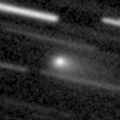
|
Now it is bright as 13.0 mag (June 13, Chris Wyatt). It will be observable at 12-13 mag in good condition from spring to summer. Juan Jose Gonzalez reported it was very bright as 10.5 mag on June 13.
Date(TT) R.A. (2000) Decl. Delta r Elong. m1 Best Time(A, h)
June 16 23 13.47 -6 10.2 1.190 1.665 97 13.1 2:58 (310, 34)
June 23 23 22.84 -4 16.5 1.155 1.683 101 13.2 3:00 (313, 39)
|

|
Now it is 14.4 mag (June 2, Ken-ichi Kadota).
Date(TT) R.A. (2000) Decl. Delta r Elong. m1 Best Time(A, h)
June 16 23 18.84 0 33.4 5.623 5.780 93 13.5 2:58 (303, 38)
June 23 23 19.94 0 51.4 5.514 5.779 100 13.4 3:00 (309, 43)
|
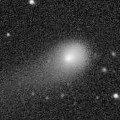
|
Now it is 13.6 mag (June 7, Thomas Lehmann). It will be observable at 12-13 mag for a long time from 2017 to 2018. In the Southern Hemisphere, it will be hardly observable after this.
Date(TT) R.A. (2000) Decl. Delta r Elong. m1 Best Time(A, h)
June 16 12 6.26 51 1.1 3.979 3.871 76 13.5 21:02 (132, 58)
June 23 11 58.85 49 33.6 4.092 3.888 71 13.5 21:04 (128, 52)
|
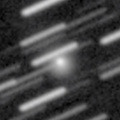
|
Now it is 14.2 mag (June 12, Toshihiko Ikemura, Hirohisa Sato). It will brighten up to 13 mag in 2019 spring. In the Northern Hemisphere, it stays observable in good condition for a long time. In the Southern Hemisphere, it locates extremely low until summer.
Date(TT) R.A. (2000) Decl. Delta r Elong. m1 Best Time(A, h)
June 16 18 7.30 45 47.7 3.360 3.835 110 14.5 0:33 (180, 79)
June 23 17 52.01 44 50.2 3.308 3.802 111 14.4 23:44 (180, 80)
|
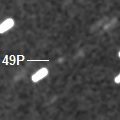
|
The condition is worst in this apparition. It brightens up to 14.5 mag from June to August, but it is not observable at all.
Date(TT) R.A. (2000) Decl. Delta r Elong. m1 Best Time(A, h)
June 16 5 8.19 14 29.5 2.451 1.467 11 15.2 2:58 (234,-20)
June 23 5 31.16 15 35.3 2.434 1.451 11 15.0 3:00 (234,-19)
|

|
Now it is 15.2 mag (May 21, Martin Masek). It stays 15 mag from 2018 to 2019, and it will be observable for a long time in the Southern Hemisphere. In the Northern Hemisphere, it will never be observable again.
Date(TT) R.A. (2000) Decl. Delta r Elong. m1 Best Time(A, h)
June 16 11 59.40 -66 2.3 3.893 4.398 113 15.1 21:02 ( 16,-16)
June 23 11 58.57 -65 33.4 3.911 4.372 110 15.1 21:04 ( 19,-17)
|

|
Now it is 19.2 mag (June 13, Toshihiko Ikemura, Hirohisa Sato). It will brighten rapidly, and it is expected to brighten up to 10 mag in autumn. But actually, it is much fainter than this ephemeris. It will be observable in excellent condition in the Northern Hemisphere. It stays low in the Southern Hemisphere.
Date(TT) R.A. (2000) Decl. Delta r Elong. m1 Best Time(A, h)
June 16 22 58.14 -3 9.8 1.687 2.115 100 15.5 2:58 (311, 39)
June 23 23 7.34 -1 30.9 1.566 2.062 103 15.2 3:00 (315, 43)
|

|
It brightened up to 7.1 mag from May to June in 2017 (June 21, Juan Jose Gonzalez). Now it is fading. It has already faded down to 14.8 mag (May 23, Martin Masek). In the Southern Hemisphere, it stays observable for a long time after this. It will never be observable again in the Northern Hemisphere.
Date(TT) R.A. (2000) Decl. Delta r Elong. m1 Best Time(A, h)
June 16 1 48.23 -44 12.8 4.549 4.579 85 15.2 2:58 (313,-16)
June 23 1 53.64 -44 45.2 4.546 4.642 89 15.3 3:00 (316,-13)
|

|
Now it is 17.2 mag (May 21, Martin Masek). It is observable at 15 mag in 2018, in good condition in the Southern Hemisphere. It locates somewhat low in the Northern Hemisphere.
Date(TT) R.A. (2000) Decl. Delta r Elong. m1 Best Time(A, h)
June 16 23 22.25 -15 10.6 2.818 3.143 99 15.5 2:58 (314, 26)
June 23 23 26.04 -15 10.3 2.739 3.155 104 15.5 3:00 (320, 29)
|

|
Now it is 15.3 mag (June 4, L. S. Amaral, P. R. Holvorcem). It stays at 14-15 mag for a long time from summer to winter. In the Southern Hemisphere, it stays observable in excellent condition for a while. But it will be getting lower rapidly in September, then it becomes unobservable after October. In the Northern Hemisphere, it stays observable for a long time until it fades out. But it stays extremely low.
Date(TT) R.A. (2000) Decl. Delta r Elong. m1 Best Time(A, h)
June 16 13 49.52 -37 42.6 1.960 2.725 129 15.8 21:02 ( 11, 16)
June 23 13 47.46 -34 21.3 1.964 2.662 123 15.7 21:04 ( 18, 18)
|

|
Now it is bright as 14.8 mag (May 26, Ken-ichi Kadota). It stays observable in good condition for a while. But it will fade out rapidly after this. It will be fainter than 18 mag in August.
Date(TT) R.A. (2000) Decl. Delta r Elong. m1 Best Time(A, h)
June 16 16 56.84 -22 36.6 1.051 2.060 170 15.7 23:14 ( 0, 33)
June 23 16 10.49 -19 28.0 1.138 2.095 153 16.0 22:01 ( 0, 36)
|

|
Now it is 16.7 mag (May 13, Hidetaka Sato). It will brighten rapidly after this, and it is expected to brighten up to 9 mag from autumn to winter. In the Northern Hemisphere, it will be getting higher gradually after July. Then it stays observable in good condition for a long time until it fades out. In the Southern Hemispehre, it is observable in good condition until autumn, but it will be low in winter.
Date(TT) R.A. (2000) Decl. Delta r Elong. m1 Best Time(A, h)
June 16 2 0.97 -4 0.1 2.742 2.386 59 16.1 2:58 (278, 4)
June 23 2 14.11 -2 55.1 2.623 2.328 62 15.8 3:00 (279, 8)
|
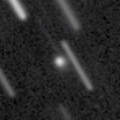
|
It brightened rapidly. Now it is 15.5 mag (June 12, Toshihiko Ikemura, Hirohisa Sato). It will be fading after this, and will be fainter than 18 mag in August.
Date(TT) R.A. (2000) Decl. Delta r Elong. m1 Best Time(A, h)
June 16 14 43.64 19 53.1 1.251 1.964 119 15.8 21:05 ( 0, 75)
June 23 14 45.23 15 43.4 1.288 1.973 117 15.9 21:04 ( 17, 70)
|
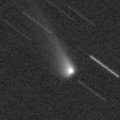
|
Now it is 17.2 mag (May 19, CAO, San Pedro de Atacama). Fading now. It stays observable in good condition for a long time after this in the Southern Hemisphere. It stays low in the Northern Hemisphere.
Date(TT) R.A. (2000) Decl. Delta r Elong. m1 Best Time(A, h)
June 16 1 0.45 -11 44.8 4.658 4.521 75 15.9 2:58 (293, 12)
June 23 1 0.45 -12 54.9 4.552 4.540 82 15.9 3:00 (299, 16)
|

|
It will brighten up to 14 mag in winter. It will be observable in excellent condition in the Northern Hemisphere. In the Southern Hemisphere, it is observable only until August.
Date(TT) R.A. (2000) Decl. Delta r Elong. m1 Best Time(A, h)
June 16 2 31.10 16 3.8 2.959 2.338 44 15.9 2:58 (257, 10)
June 23 2 42.02 18 14.9 2.862 2.302 47 15.9 3:00 (258, 15)
|
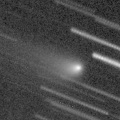
|
It is fading now, but it stays 16 mag until summer. But actually, it is 18.1 mag (Mar. 23, Toshihiko Ikemura, Hirohisa Sato), fainter than this ephemeris.
Date(TT) R.A. (2000) Decl. Delta r Elong. m1 Best Time(A, h)
June 16 16 55.35 -28 14.1 2.990 3.993 169 16.1 23:15 ( 0, 27)
June 23 16 39.89 -28 2.5 3.071 4.042 160 16.2 22:33 ( 0, 27)
|

|
Now it is 16.2 mag (June 17, Jean-Francois Soulier). It stays 16 mag for a while. In the Southern Hemisphere, it stays observable until August, but it will be unobservable after that. In the Northern Hemisphere, it becomes observable in good condition after this. Its cometary activity was observed on Mar. 26 (M. Mommert, D. Polishook, N. Moskovitz).
Date(TT) R.A. (2000) Decl. Delta r Elong. m1 Best Time(A, h)
June 16 1 34.87 5 37.0 1.504 1.340 60 16.1 2:58 (274, 15)
June 23 1 47.67 9 28.1 1.500 1.376 62 16.2 3:00 (273, 21)
|
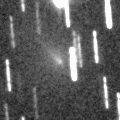
|
It stays observable at 16.5 mag for a while. It will be observable in good condition after this in the Southern Hemisphere. But it stays low in the Northern Hemisphere.
Date(TT) R.A. (2000) Decl. Delta r Elong. m1 Best Time(A, h)
June 16 21 37.12 -27 32.4 1.364 2.127 126 16.5 2:58 (344, 26)
June 23 21 6.60 -32 41.1 1.315 2.189 139 16.5 3:00 (359, 23)
|
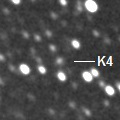
|
Now it is 17.2 mag (May 21, Toshihiko Ikemura, Hirohisa Sato). It was observed at 16 mag from summer to autumn in 2017. It will be observable at 16.5 mag in good condition also in 2018. It locates somewhat low in the Southern Hemisphere.
Date(TT) R.A. (2000) Decl. Delta r Elong. m1 Best Time(A, h)
June 16 0 39.39 18 53.4 3.302 3.081 68 16.5 2:58 (270, 34)
June 23 0 46.03 20 12.8 3.254 3.116 73 16.5 3:00 (271, 39)
|
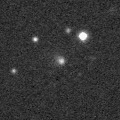
|
Unexpectedly, it brightened rapidly. Now it is 16.6 mag (May 15, Toshihiko Ikemura, Hirohisa Sato). It stays at 16.5 mag until July.
Date(TT) R.A. (2000) Decl. Delta r Elong. m1 Best Time(A, h)
June 16 12 39.26 1 11.6 1.596 2.088 103 16.5 21:02 ( 46, 46)
June 23 12 46.91 0 41.0 1.657 2.078 99 16.5 21:04 ( 52, 42)
|

|
Now it is 15.9 mag (May 4, Kunihiro Shima). It will be fading slowly until summer.
Date(TT) R.A. (2000) Decl. Delta r Elong. m1 Best Time(A, h)
June 16 11 32.98 9 52.9 3.507 3.571 85 16.7 21:02 ( 71, 40)
June 23 11 37.48 9 9.9 3.608 3.574 79 16.7 21:04 ( 75, 35)
|

|
Now it is 16.6 mag (May 10, Toshihiko Ikemura, Hirohisa Sato). It will be fading slowly after this.
Date(TT) R.A. (2000) Decl. Delta r Elong. m1 Best Time(A, h)
June 16 10 25.61 9 17.4 9.979 9.682 70 16.9 21:02 ( 82, 27)
June 23 10 27.85 9 14.1 10.090 9.688 64 16.9 21:04 ( 86, 21)
|
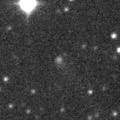
|
Now it is 16.9 mag (May 15, Toshihiko Ikemura, Hirohisa Sato). It will be fainter than 18 mag in summer.
Date(TT) R.A. (2000) Decl. Delta r Elong. m1 Best Time(A, h)
June 16 14 29.47 -5 26.7 5.773 6.492 131 16.9 21:02 ( 4, 49)
June 23 14 28.11 -4 51.4 5.882 6.512 124 17.0 21:04 ( 16, 49)
|

|
Now it is 17.1 mag (June 13, Toshihiko Ikemura, Hirohisa Sato). It will be fading gradually after this, and it will be fainter than 18 mag in winter. In the Northern Hemisphere, it stays observable in good condition for a long time. In the Southern Hemisphere, it will never be observable again.
Date(TT) R.A. (2000) Decl. Delta r Elong. m1 Best Time(A, h)
June 16 23 36.57 72 52.2 7.606 7.282 67 17.0 2:58 (197, 46)
June 23 23 41.32 73 35.1 7.604 7.306 69 17.0 3:00 (195, 47)
|
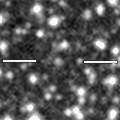
|
Now it is 17.9 mag (June 13, Toshihiko Ikemura, Hirohisa Sato). It stays observable at 17 mag in good condition from spring to autumn.
Date(TT) R.A. (2000) Decl. Delta r Elong. m1 Best Time(A, h)
June 16 21 2.12 1 39.5 5.361 5.990 124 17.1 2:58 (347, 56)
June 23 21 1.57 1 53.0 5.284 5.991 130 17.1 2:59 ( 0, 57)
|
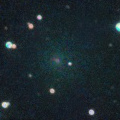
|
It brightened very rapidly, and it brightened so much up to 11.8 mag in May (May 16, Juan Jose Gonzalez). It seems to be fading rapidly after that. It has already faded down to 16.9 mag (June 1, Yuji Ohshima). In the Northern Hemisphere, it stays observable until it fades out. It is not observable in the Southern Hemisphere.
Date(TT) R.A. (2000) Decl. Delta r Elong. m1 Best Time(A, h)
June 16 4 36.79 84 22.3 1.808 1.591 61 17.1 2:58 (186, 32)
June 23 4 9.09 84 48.4 1.817 1.614 62 20.1 3:00 (186, 33)
|
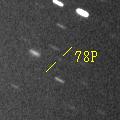
|
Now it is 17.2 mag (June 13, Toshihiko Ikemura, Hirohisa Sato). It stays at 13 mag for a long time from winter to autumn in 2019. It stays observable in good condition until winter when the comet brightens up to 13 mag.
Date(TT) R.A. (2000) Decl. Delta r Elong. m1 Best Time(A, h)
June 16 22 1.19 -4 5.9 2.408 2.962 113 18.1 2:58 (328, 46)
June 23 22 3.02 -3 39.7 2.293 2.930 119 17.8 3:00 (337, 49)
|
|
![]()
 C/2015 V2 ( Johnson )
C/2015 V2 ( Johnson ) 65P/Gunn
65P/Gunn C/2018 L2 ( ATLAS )
C/2018 L2 ( ATLAS ) C/2018 K1 ( Weiland )
C/2018 K1 ( Weiland ) 38P/Stephan-Oterma
38P/Stephan-Oterma C/2018 C2 ( Lemmon )
C/2018 C2 ( Lemmon ) C/2015 V1 ( PanSTARRS )
C/2015 V1 ( PanSTARRS ) (944) Hidalgo
(944) Hidalgo C/2015 VL62 ( Lemmon-Yeung-PanSTARRS )
C/2015 VL62 ( Lemmon-Yeung-PanSTARRS ) (3552) Don Quixote
(3552) Don Quixote C/2017 S6 ( Catalina )
C/2017 S6 ( Catalina ) C/2017 K4 ( ATLAS )
C/2017 K4 ( ATLAS ) 105P/Singer Brewster
105P/Singer Brewster 74P/Smirnova-Chernykh
74P/Smirnova-Chernykh C/2014 B1 ( Schwartz )
C/2014 B1 ( Schwartz ) C/2017 E3 ( PanSTARRS )
C/2017 E3 ( PanSTARRS ) C/2014 OE4 ( PanSTARRS )
C/2014 OE4 ( PanSTARRS ) C/2017 M5 ( TOTAS )
C/2017 M5 ( TOTAS ) C/2018 EF9 ( Lemmon )
C/2018 EF9 ( Lemmon ) 78P/Gehrels 2
78P/Gehrels 2![]()





























